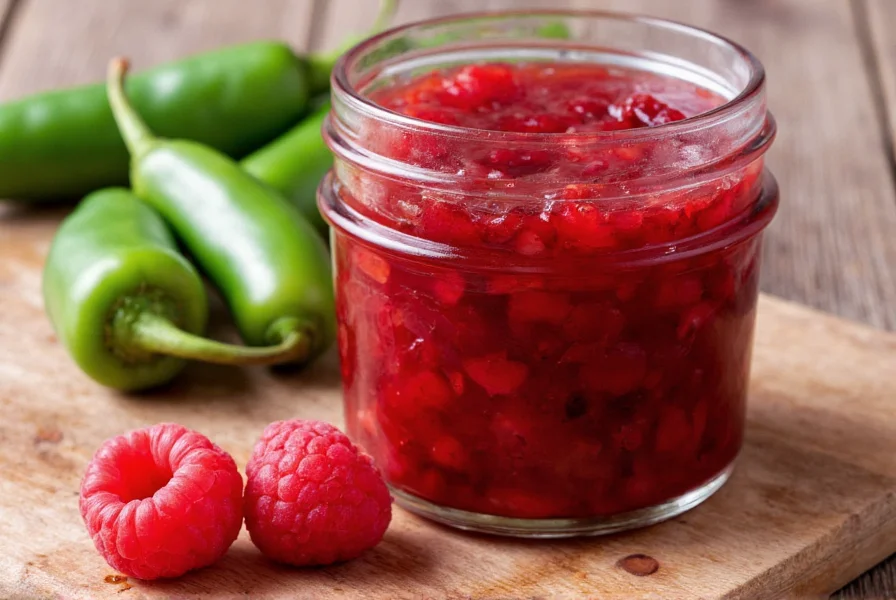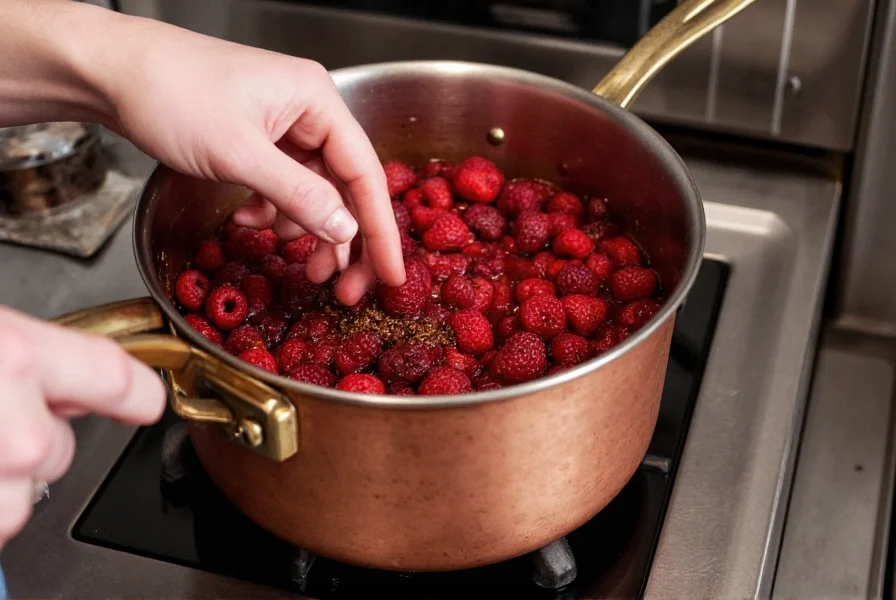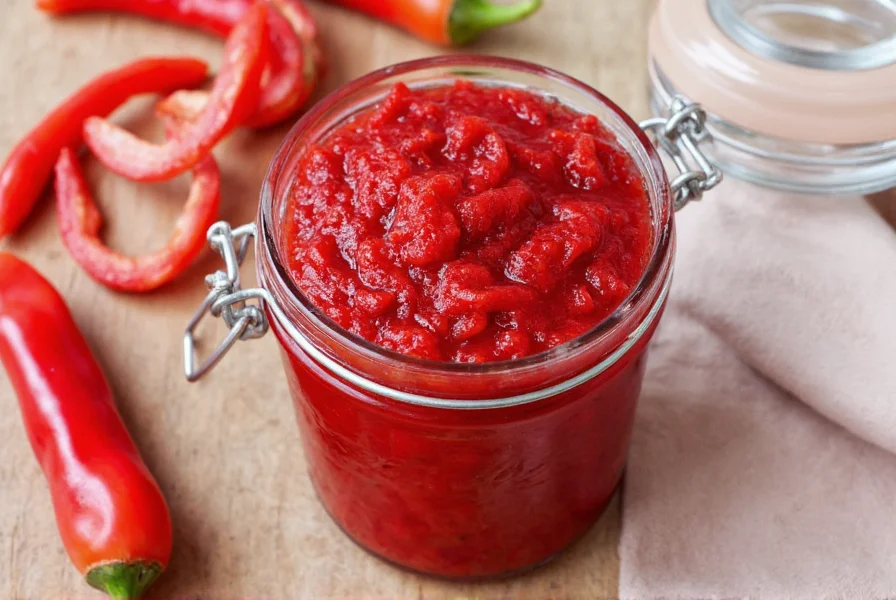Raspberry pepper jam represents one of the most exciting flavor combinations in modern preserves. Unlike traditional fruit jams, this innovative spread intentionally incorporates the heat of chili peppers to create a complex taste experience that elevates both sweet and savory dishes. The magic happens when the natural pectin in raspberries sets with sugar while the capsaicin from peppers infuses throughout the mixture.
The Perfect Sweet-Heat Balance
What makes raspberry pepper jam special is its carefully calibrated ratio of sweet to spicy. Most quality recipes maintain a 4:1 ratio of raspberries to peppers, ensuring the fruit flavor remains dominant while the heat provides an intriguing background note. The specific pepper variety dramatically affects the final product:
| Pepper Type | Heat Level (Scoville) | Flavor Profile | Best For |
|---|---|---|---|
| Jalapeño | 2,500-8,000 | Grassy, fresh | Beginner-friendly heat |
| Serrano | 10,000-23,000 | Bright, citrusy | Intermediate heat lovers |
| Habanero | 100,000-350,000 | Tropical, floral | Adventurous palates |
| Chipotle | 2,500-8,000 | Smoky, earthy | Savory applications |
Professional jam makers emphasize that seed removal significantly impacts heat control. "The seeds and white membranes contain most of the capsaicin," explains culinary expert Maria Chen. "For a milder jam, carefully remove these elements before cooking. For more intense heat, leave them intact or add additional pepper seeds."

Unexpected Culinary Applications
While many assume raspberry pepper jam belongs exclusively on toast, its versatility extends far beyond breakfast. The sweet-spicy profile makes it an exceptional pairing agent that bridges flavor gaps between ingredients.
Cheese pairings represent one of the most sophisticated uses. The jam's acidity cuts through rich cheeses while the heat complements their saltiness. Brie, goat cheese, and aged cheddar create particularly harmonious combinations. For entertaining, spread softened goat cheese on crostini, top with raspberry pepper jam, and finish with fresh thyme.
Chef Marcus Reynolds recommends using raspberry habanero jam as a glaze for proteins. "Brush it on salmon during the last five minutes of grilling, or mix with soy sauce and garlic for an exceptional pork tenderloin marinade. The果 pectin creates a beautiful caramelized crust while the heat penetrates the meat."
Unexpectedly, raspberry chipotle jam elevates dessert applications. Swirl it into cheesecake batter, use as a filling between cake layers, or drizzle over vanilla ice cream. The heat becomes more pronounced as the sweetness fades, creating a dynamic flavor journey.
Homemade vs. Commercial Options
While artisanal brands like Urban Accents and Stonewall Kitchen offer quality raspberry jalapeno pepper jam, homemade versions allow for complete flavor customization. The basic process requires:
- 4 cups fresh or frozen raspberries
- 1-2 chopped peppers (depending on heat preference)
- 2 cups sugar
- 2 tablespoons lemon juice
- 1 package pectin (optional for firmer set)
"The secret to perfect homemade raspberry habanero jam recipe success lies in temperature control," advises home preserving expert David Miller. "Cook to precisely 220°F (104°C)—the gel point for most jams. Too low and it won't set; too high and you'll caramelize the sugars, altering both texture and flavor."

For those without time for homemade preserves, look for products with minimal ingredients—ideally just fruit, peppers, sugar, and lemon juice. Avoid options with artificial flavors, high fructose corn syrup, or unnecessary preservatives. The best commercial raspberry pepper jams maintain visible fruit pieces and a vibrant red color without appearing unnaturally bright.
Storage and Shelf Life Considerations
Properly canned raspberry pepper jam maintains quality for 12-18 months in a cool, dark pantry. Once opened, refrigerate and consume within 3 weeks. The acidity from both raspberries and peppers creates a naturally preservative environment, though sugar content also affects longevity.
Freezing represents an excellent option for preserving seasonal raspberry harvests. "Portion into ice cube trays, then transfer frozen cubes to airtight bags," suggests preservation specialist Elena Rodriguez. "This method allows you to use only what you need while maintaining optimal flavor for up to 12 months."
Frequently Asked Questions
What foods pair best with raspberry pepper jam?
Raspberry pepper jam complements both sweet and savory dishes. Excellent pairings include brie or goat cheese, grilled chicken or pork, morning toast with cream cheese, and even as a swirl in vanilla yogurt. For unexpected combinations, try it with roasted duck, alongside cornbread, or as a topping for vanilla ice cream.
How spicy is raspberry jalapeno pepper jam typically?
Most commercial raspberry jalapeno pepper jam registers as mild to medium on the heat scale. The sweetness of raspberries significantly tempers the jalapeño's heat, creating a background warmth rather than intense spiciness. Homemade versions can be adjusted by controlling seed quantity—removing seeds creates milder jam while including them increases heat.
Can I substitute other berries in a raspberry habanero jam recipe?
Yes, but with flavor considerations. Blackberries create a deeper, earthier profile while strawberries produce a brighter, more acidic jam. Blueberries require additional pectin due to lower natural pectin content. When substituting, maintain the same berry-to-pepper ratio (typically 4:1) to preserve the sweet-heat balance that defines this preserve style.
Does raspberry chipotle jam contain actual chipotle peppers?
Authentic raspberry chipotle jam uses smoked and dried jalapeños (chipotles) rather than chipotle powder. The whole peppers impart a distinctive smoky flavor that powder cannot replicate. Quality products will specify 'chipotle peppers in adobo' or similar phrasing in ingredients. Avoid products listing 'chipotle flavor' which often indicates artificial flavoring rather than real peppers.
How can I reduce the heat in raspberry pepper jam if it's too spicy?
To mellow excessive heat, add additional raspberry puree or a small amount of honey to balance the spiciness. For future batches, remove all seeds and membranes from peppers before cooking. When making jam from scratch, you can also introduce heat gradually—start with half a pepper and taste before adding more. Remember that heat perception diminishes slightly after the jam cools and sets.











 浙公网安备
33010002000092号
浙公网安备
33010002000092号 浙B2-20120091-4
浙B2-20120091-4